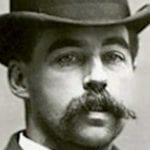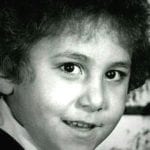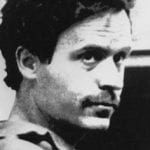 Politics
Politics  Politics
Politics  Weird Stuff
Weird Stuff Ten Bizarre Facts About The Doge Meme
 Our World
Our World 10 Ways Your Christmas Tree Is More Lit Than You Think
 Movies and TV
Movies and TV The 10 Coolest Stars to Set Sail on The Love Boat
 History
History 10 Things You Didn’t Know About the American National Anthem
 Technology
Technology Top 10 Everyday Tech Buzzwords That Hide a Darker Past
 Humans
Humans 10 Everyday Human Behaviors That Are Actually Survival Instincts
 Animals
Animals 10 Animals That Humiliated and Harmed Historical Leaders
 History
History 10 Most Influential Protests in Modern History
 Creepy
Creepy 10 More Representations of Death from Myth, Legend, and Folktale
 Politics
Politics 10 Political Scandals That Sent Crowds Into the Streets
 Weird Stuff
Weird Stuff Ten Bizarre Facts About The Doge Meme
 Our World
Our World 10 Ways Your Christmas Tree Is More Lit Than You Think
Who's Behind Listverse?

Jamie Frater
Head Editor
Jamie founded Listverse due to an insatiable desire to share fascinating, obscure, and bizarre facts. He has been a guest speaker on numerous national radio and television stations and is a five time published author.
More About Us Movies and TV
Movies and TV The 10 Coolest Stars to Set Sail on The Love Boat
 History
History 10 Things You Didn’t Know About the American National Anthem
 Technology
Technology Top 10 Everyday Tech Buzzwords That Hide a Darker Past
 Humans
Humans 10 Everyday Human Behaviors That Are Actually Survival Instincts
 Animals
Animals 10 Animals That Humiliated and Harmed Historical Leaders
 History
History 10 Most Influential Protests in Modern History
 Creepy
Creepy 10 More Representations of Death from Myth, Legend, and Folktale
10 Still-Unidentified Serial Killers
Thanks to advances in technology, specifically forensics, law enforcement agencies throughout the world are better-equipped these days to tackle the scourge of serial killers. Seemingly gone are the days of the 1970s and 1980s, when serial killer stories dominated the news from the Unites States to Australia. This sense of safety is relative, however.
There are still serial killers out there who have never been caught. While some of the monsters on this list are undoubtedly dead, others could still be alive. The search goes on for these ten serial killers, and hopefully, we all live to see the day when they are brought into the light just like Joseph James DeAngelo, the suspected Golden State Killer.
10 Dr. No

The case of the Ohio Prostitute Killer, also known as “Dr. No,” first came to the attention of local crime reporters following the discovery of the body of 23-year-old Shirley Dean Taylor. Taylor’s body was found behind a traffic barrier in Medina County, Ohio, on July 20, 1986. Taylor was known in the area as a “working girl.” Her killer not only beat her to death but also removed all of her jewelry and almost all of her clothing.
Similar killings in Ohio stretched over a decade. On February 8, 1987, 27-year-old Anna Marie Patterson was found dead alongside Interstate 71 near Cincinnati. It was investigative reporter Michael Berens of The Columbus Dispatch who noticed that Patterson, reportedly the sixth victim in the series, fit a pattern. An autopsy of Patterson’s corpse revealed that she had been viciously beaten and killed within 48 hours of her initial disappearance in January 1987. The autopsy also revealed that Patterson’s body had been kept in a refrigerator for some time, thus indicating a killer who was either a necrophile or a possible cannibal.
Berens also discovered that Patterson had been looking for customers at a truck stop in Austintown, Ohio, a small town just south of Cleveland. Eyewitnesses told Berens and the police that Patterson’s last call came from a commercial truck with the C.B. handle “Doctor No.”[1] The aforementioned refrigeration of Patterson’s body may have come as a result of Dr. No’s line of work as a truck driver carrying a refrigerated trailer.
Other suspected victims of Dr. No include Patricia Corley, a woman who was found beaten to death near Interstate 70 on April 9, 1992. For 24 years, Corley would only be known as “Jane Doe” until a DNA examination revealed her true identity in October 2016. At the time of her murder, Corley was a 29-year-old mother with an infant son. Corley was beaten to death with a blunt object like the others, and also like the others, Corley had some connection with truck stops. (Her body was found near one.)
Another one of the killer’s possible victims was identified in 2018 as Marcia King, a 21-year-old originally from Little Rock, Arkansas, who was found wearing a unique buckskin jacket on April 24, 1981. King’s body had been discovered on Greenlee Road near Troy, Ohio. She had been beaten to death with some kind of blunt object and had only been dead for hours when her body was found. Berens believes that King was Dr. No’s first victim.
Information about Dr. No or the Ohio Prostitute Killer continues to leak out in the regional American press. In May 2017, former investigator for Warren County, Ohio, Mark Duvelius stated that Dr. No was a Middle Eastern man with long, dark hair who was between the ages of 25 and 40 at the time of the Patterson murder. In 2019, 49-year-old Samuel Legg III was indicted in an Arizona court on three counts of aggravated murder and one count of murder. All of these crimes took place in Ohio’s Mahoning County. So far, there is plenty of evidence, specifically DNA evidence, to suggest that Legg is responsible for the murder of Patricia Corley, as well as other murders in Northeastern Ohio. Another tantalizing fact is that Legg worked for many years as a long-haul truck driver.
Not all are convinced that Legg is the infamous Dr. No, and many more doubt that he carried out the Marcia King murder.
9 Rainbow Maniac

Known alternatively as the Paturis Park murderer, Brazil’s Rainbow Maniac is a serial killer who targeted the homosexual residents of Carapicuiba, a city of 400,000 inside of the larger metropolis of Sao Paulo. The killer is currently believed to be responsible for 13 deaths and may well have killed three other men in the neighboring city of Osasco.
The maniac got his first taste of blood on July 4, 2007, when he murdered 32-year-old Jose Cicero Henrqiue inside Paturis Park. Most of the Rainbow Maniac’s subsequent victims fit the pattern first established by the Henrique killing—their bodies were partially stripped before or after death and then dumped in the park’s undergrowth. Almost all of the victims were found with their pants wrapped around their knees, and every one of them was shot with a .38-caliber pistol.[2]
More than a year after the murders began, a former police sergeant named Jairo Francisco Franco was taken into custody and questioned about his possible involvement in the murders. The main evidence against Franco was an eyewitness who claimed that he or she had seen Franco in Paturis on the night of one of the murders. Another witness also came forward to say that Franco was known to “cruise” (i.e. look for sexual encounters) in Paturis.
Despite the Brazilian police telling the press that they were confident that Franco was their man, he was released back into the public on August 23, 2011, after being found not guilty by a jury by a score of four votes to two.
8 Freeway Phantom
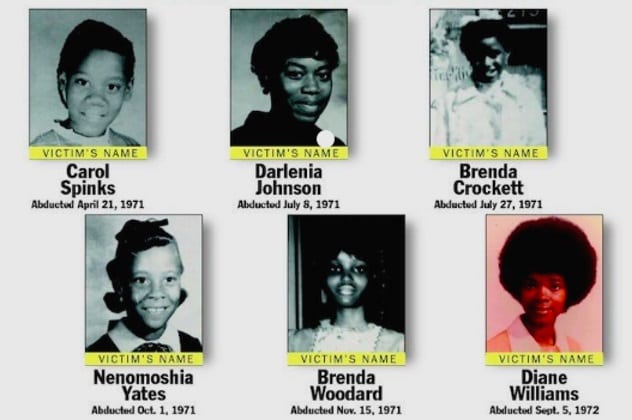
Washington, DC, was in a bad way in the late 1960s and early 1970s. Following the assassination of Martin Luther King Jr., the city erupted into four days of rioting that ultimately killed 13 people and damaged 900 different businesses. By 1970, African Americans made up 71 percent of the city’s population, while the white population continued to decline as white residents moved to the suburbs of Maryland and Northern Virginia.
In the midst of this bubbling cauldron of racial animosity and violence, the Freeway Phantom appeared. The crime wave started on April 21, 1971. On that evening, 13-year-old Carol Denise Spinks was told to go to a nearby 7-Eleven by her older sister, 24-year-old Valerie. Carol was given $5 and instructions to get groceries and soda pop. She never made it back to her family’s Congress Heights apartment. Carol was abducted, and her body was not found until six days later, not far from Interstate 295 and the Suitland Parkway. Carol had been sexually assaulted (specifically sodomized), beaten severely, cut across her face, torso, and arms, and strangled to death. A later autopsy revealed that Carol had been kept alive by her killer for several days before her body was discovered.
The killer’s next victim, 16-year-old Darlenia Johnson, who lived in the same Congress Heights neighborhood as the Spinks family, was abducted on July 8, 1971, while she was traveling to her job as a summer counselor at the Oxon Hill Recreation Center. In this instance, an eyewitness came forward to say that he saw Johnson riding in an older-model car with an older black male driver. Johnson’s body would later be found only 4.6 meters (15 ft) away from the spot where Carol Spinks’s body had been found. Heavy decomposition made it impossible for the authorities to tell whether or not Darlenia had been sexually assaulted, but the cause of death was strangulation.[3]
The third victim, ten-year-old Brenda Crockett, was discovered on July 28 near an underpass located on US Highway 50. She had been strangled to death. Like Carol, Brenda had been abducted as she walked to the grocery store.
Before the dreadful year of 1971 would be over, the Freeway Phantom would claim two more victims. Twelve-year-old Nenomoshia Yates was abducted on October 1, and her body was found six days later on Pennsylvania Avenue. Yates had been strangled to death. The killer’s oldest victim, 18-year-old Brenda Denise Woodard, was kidnapped from a bus stop on November 15, stabbed multiple times, and then thrown away like so much trash near the Prince George’s County Hospital. Woodard’s killer left a taunting note near body which read: “This is tantamount to my insensitivity to people especially women. I will admit the others when you catch me if you can!” The missive was signed “Free-way Phantom.”
The final victim, 17-year-old high school senior Diane Williams, went missing after boarding a bus. Her body was found alongside I-295. She had not only been strangled to death, but her body was dumped just 8 kilometers (5 mi) away from where Carol Spinks had been found. Despite several accusations that DC’s Metropolitan Police Department did not devote any serious resources toward catching the killer (a double accusation as it also accused the police of racism), several suspects were questioned in the case. Some of these suspects include members of the Green Vega Rapists, a gang known for abducting and raping DC-area girls while out riding in a green Chevrolet Vega. However, alibis were provided by gang members. Two former police officers, Edward Sullivan and Tommie Simmons, were also questioned, but they were only suspected in the murder of Angela Denise Barnes, a victim not included in the Freeway Phantom series.
7 The Alphabet Killer

Like the case of Dr. No, the identity of the Alphabet Killer (also known as the Double Initial Killer) of Rochester, New York, may have been revealed thanks to 21st-century science. On August 20, 2013, 79-year-old New York native Joseph Naso was convicted in a California court for the murders of Carmen Colon, Pamela Parsons, Roxene Roggasch, Tracy Tofoya, and two other women. The Marin County court sentenced Naso to death. Naso did not take too kindly to this ruling, stating that, “This [the verdict] was kind of like a hate crime against me,” before flipping his middle finger to the jury.
Besides Naso’s New York connection and his job as a professional photographer (an occupation which saw Naso travel extensively back and forth between New York and California), the other circumstantial evidence against Naso includes the similarities between his California victims and the Rochester victims of 1971 and 1973. Like the later victims in the Golden State, all three victims in New York were raped and strangled, plus they had double initials.
Ten-year-old Carmen Colon (not to be confused with the California victim) disappeared from her Bull’s Head neighborhood on November 16, 1971. Her body was found two days later, lying against a rock near the town of Riga. She had been strangled to death and sexually assaulted. Seventeen months later, 11-year-old Wanda Walkowicz went missing from Avenue D in Rochester, and a day later, she was found dead in a rest stop in Webster, New York. The last victim, 11-year-old Michelle Maenza, was abducted near her Webster Crescent home and then found two days later in the small town of Macedon, New York.[4]
Besides Naso, another man suspected of being the Alphabet Killer, Kenneth Bianchi, lived and worked in Rochester during the time of the murders. Bianchi and his cousin Angelo Buono would later murder several women in Los Angeles as the Hillside Stranglers. The one fact that provides doubt concerning the responsibility of either Naso or Bianchi is the fact that both men were convicted of murdering adult females, not little girls.
6 New Bedford Highway Killer
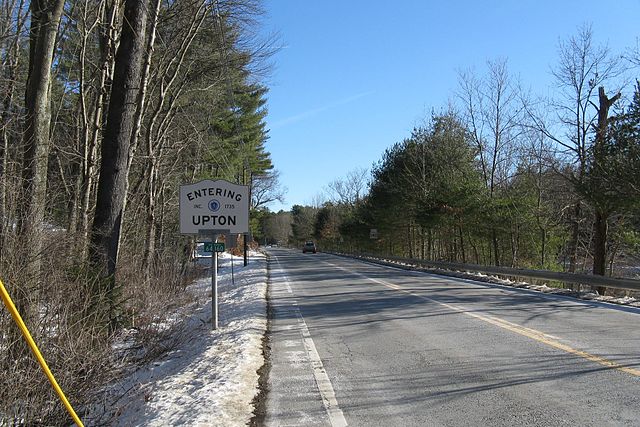
Between 1988 and 1989, the small city of New Bedford, Massachusetts, became the home of an as-yet unidentified serial killer. The first victim to be found, 29-year-old Fall River, Massachusetts, native Debra Medeiros, was discovered on July 3, 1988, off of Route 140 North. Medeiros had initially been reported missing by her mother, who was worried about her daughter following a particularly nasty argument between Debra and her boyfriend. Debra’s body was skeletal by the time it was found.
The killer’s other victims were all found between the late autumn of 1988 and the spring of 1989. The victims included 28-year-old Robbin Rhodes, who had last been seen in New Bedford sometime in either March or April 1988; 28-year-old Rochelle Clifford Dopierala, who had last been seen in New Bedford in April 1988; 25-year-old Debroh Lynn McConnell, who was last seen by her family in May 1988; 35-year-old Debra DeMello, who was last seen walking away from a prison work-release program on June 18, 1988; 36-year-old Nancy Paiva, who went missing on July 7, 1988; 25-year-old Dawn Mendes, who went missing on September 4, 1988; 26-year-old Mary Rose Santos, who was last seen on July 16, 1988; and 24-year-old Sandra Botelho, who was last seen on August 11, 1988.[5] All of these victims were either known drug addicts or known prostitutes, and their bodies were all discovered on or near Route 140, Interstate 195, or Route 88.
During the investigation, three men were questioned and interviewed. The first, Anthony R. DeGrazia, lived in Lakeville, Massachusetts. DeGrazia had been identified by a New Bedford prostitute, who claimed that DeGrazia, who had a distinctively flat nose, had assaulted her sometime in 1988. DeGrazia would later be charged with 17 rapes and assaults, but after over a year of incarceration, DeGrazia was released on bail in January 1990. He committed suicide a few months later.
Daniel Tavares Jr. became a major suspect years later in 2015. In that year, Tavares, who knew victim Sandra Botelho, was convicted of the 1988 murder of Gayle Botelho. Tavares had killed Gayle over a cocaine debt. The conviction was a long time in coming, for Gayle’s remains were found buried in Tavares’s backyard in 2000. At that time, Tavares was already in prison for the 1991 murder of his mother, Ann Tavares.
The suspect favored by most writers and amateur criminologists is Kenneth C. Ponte. Ponte was indicted in 1990 for the murder of Rochelle Dopierala. Ponte had previously been arrested for drug-related offenses as well as offenses related to his relationship with Dopierala. Ponte also briefly relocated to Florida in 1988 before most of the victims were discovered. Ponte, a lawyer, also fit one of the profiles of the New Bedford Killer, who profilers suggested had a working knowledge of law enforcement techniques. While the 1990 charges against Ponte were dropped, he was arrested again in 2009 for shoplifting. In 2010, he was found dead in his New Bedford home.
5 Stoneman

Some believe that the Stoneman is nothing more than an urban legend. After all, Mumbai has a stoneman-like figure, too. However, in the city of Kolkata, India, 13 people were murdered over a period of six months in 1989. All 13 victims were homeless, killed around midnight or during the early morning hours, and were hit on the head with heavy stones.
Tragically, due to the indigent circumstances of all of the victims, none have yet been identified by the Kolkata police. All they could say for years was that they believed that the killer was a young man with a serious mental illness, possibly paranoid schizophrenia. The police at the time all but admitted that the murders of homeless and mentally unstable people did not interest either the general public or many in the Indian judicial system.[6]
Amazingly, the Kolkata Stoneman is not the only “stoneman” serial killer in India’s history. Maheshwar Padhi was arrested in 2000 and accused of killing seven different people in the town of Berhampur in South Orissa. Like the madman of Kolkata, Padhi killed his victims by caving in their skulls with large stones.
4 Seven Bridges Killer

Edgecombe and Halifax counties in North Carolina rarely make the news. The only place you can call a city in these mostly rural counties is Rocky Mount. Here is the place where the Seven Bridges Killer has been most active in preying on young black women who are either prostitutes, drug addicts, or both.
Twenty-nine-year-old Melody Wiggins was one of the first victims to be found. Back in 2005, Melody’s body was found by a farmer out near Seven Bridges Road. The farmer initially thought that he had stumbled upon a deer’s carcass, but, much to his horror, he had actually found Melody’s skeletal remains, infested with maggots and beetles.
The next to be found was Nikki Thorpe, better known as Miss Jackie. Reared in the rough-and-tumble projects of Stokes Street, Miss Jackie was known to braid the hair of local crack addicts and dealers, who would pay her with drugs and sometimes sex. Miss Jackie’s body was found rotting alongside Seven Bridges Road as well. Like Melody and another victim, 50-year-old Ernestine Battle, there was not enough left of Miss Jackie to accurately deduce a cause of death.[7] Miss Jackie and Ernestine both knew each other. Two years later, the body of 31-year-old Jarniece Latonya Hargrove was found by a farmer in a wooded area within 16 kilometers (10 mi) of the other victims. The Seven Bridges killer is suspected of murdering Wiggins, Thorpe, Battle, 40-year-old Roberta Williams, 43-year-old Christine Marie Boone, and others.
One of the strongest suspects in the case, Antwan Pittman, was convicted in 2011 of the murder of 28-year-old Tarahara Nicholson. Nicholson had been found strangled to death in a patch of woods 8 kilometers (5 mi) from her childhood home on March 7, 2009. Pittman, a native of Edgecombe County, is the chief suspect in seven of the Seven Bridges cases. He has not yet been charged with any of these murders, though.
3 Atlanta Ripper

Between 1911 and 1912, an unidentified serial killer left the bodies of several black and mixed-race women dead in the streets of Atlanta. The Atlanta newspapers alternatively ignored the murders or sensationalized them, calling the killer “Jack the Ripper” after the infamous serial killer of 1888 London. The American “Jack the Ripper” later became known simply as the Atlanta Ripper. Like his more famous namesake, this ripper has also gone unnamed for over a century.
Between May 20 and July 1, 1911, on a succession of seven Saturday nights, the Atlanta Ripper claimed the lives of several women, almost of all whom were described as attractive and well-dressed by the city’s white reporters. None of the killer’s early victims were raped, but all were stabbed to death before being horribly mutilated. This latter fact highlighted that the crimes were sexual in nature.
The killer’s seventh known victim, 40-year-old Lena Sharp, had nearly been decapitated by her assailant. Sharp’s murder provided the Atlanta police with one of their first clues. When her mother failed to return home, Sharp’s young daughter went out looking for her. Along the way, she bumped into a well-dressed black man whose personality scared her. When the young woman tried to run away from the man, he pulled out a knife and stabbed her in the back.[8]
The killer’s next period of activity included a ten-month spell during which he murdered and mutilated 13 different women. The last known victim fell on Friday, May 10, 1912. Only a few of the Atlanta Ripper’s victims have ever been named (Lena Sharp and Belle Walker, the latter of whom was killed on May 28, 1911), while concrete details are scare. All told, the Atlanta Ripper is likely to have killed 21 women.
2 Hwaseong Serial Killer

The most infamous unsolved string of murders in South Korean history began in 1986 and lasted all the way until 1991. In the city of Hwaseong in Gyeonggi Province, ten women, ranging in age between 14 and 71, were found murdered. The case involved scores of police officers and approximately 3,000 suspects.
The killer’s first known victim, 71-year-old Lee Wan-im, was found on September 15, 1986 in a cow pasture. Other victims included 25-year-old Park Hyun-sook, 25-year-old Kwon Jung-bon, 23-year-old Lee Kye-sook, 19-year-old Hong Jin-young, 29-year-old Park Eun-joo, 54-year-old Ahn Gi-soon, 14-year-old Park Sang-hee, 14-year-old Kim Mi-jung, and 69-year-old Kwon Soon-sang. In every instance, the victim had been raped.
When Park Sang-hee was discovered on September 16, 1988, detectives found a strand of hair that did not belong to the victim. This follicle eventually lead to the arrest of a 22-year-old man named Yoon. This suspect would be released on July 27, 1989, due to a lack of evidence. Another major piece of evidence occurred following the death of Ahn Gi-soon. An eyewitness saw the 54-year-old woman riding with an unknown man on the night of her murder. A composite sketch was later released, and the man was described as being in his twenties, between 165 and 170 centimeters tall (5’5″–5’7″), and with an oval face that lacked double eyelids.[9]
The case of the Hwaseong serial killer was revived in 2007, when two women went missing in the city. The missing women were identified as 52-year-old Park and 46-year-old Bae. Park was described as a bookkeeper, while Bae worked as a hostess at a karaoke bar. Both women went missing a mere 10 kilometers (6 mi) from the original crime scenes of 1986 to 1991. Furthermore, in 2004, a teenage girl was also found murdered in Hwaseong. That case has not been solved, either.
1 Volga Maniac
One of the world’s worst serial killers remains unknown, even after killing 32 elderly women between 2011 and 2012. Known as the Volga Maniac, this Russian serial killer struck in several states, including Kazan, Nizhny Novgorod, Izhevsk, Perm, Ufa, Samara, and Ulyanovsk. In the Russian media, the killer has been described as slim, between the ages of 20 and 35, and somewhere around 175 centimeters tall (5’9″). Security camera footage from one of the crime scenes shows what could be the killer wearing a dark jacket, a knit cap, tennis shoes, and a dark pants.[10] Some Russian media outlets have also described the killer as non-Slavic in appearance, which most likely means that he is suspected of belonging to one of Russia’s many Muslim or Christian minority groups from the Caucasus or Central Asia.
There is not a great deal in the Anglophone media about this serial killer. His victims range in ages from 75 to 90, and almost all of them lived in public housing blocks near the Volga River. The killer is believed to be a native of Tatarstan and most likely went to school near Kazan during the time of the murders.
The killer’s modus operandi involved him posing as an official with the Russian government, most likely social services. All of the killer’s victims were strangled and then robbed. However, despite the frequent appearance of robbery, Russian investigators do not believe that money was the killer’s primary motivation.
Benjamin Welton is a freelance writer based in Boston.
Read about more serial killers who were never caught on 10 Terrifying American Serial Killers Still At Large and 10 More Serial Killers Who Were Never Identified.





